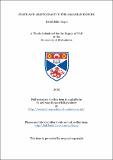Files in this item
State and aristocracy in the Sasanian Empire
Item metadata
| dc.contributor.advisor | Greenwood, Tim | |
| dc.contributor.author | Bagot, David John | |
| dc.coverage.spatial | xii, 272 p. | en_US |
| dc.date.accessioned | 2015-07-09T14:07:35Z | |
| dc.date.available | 2015-07-09T14:07:35Z | |
| dc.date.issued | 2015-06-25 | |
| dc.identifier.uri | https://hdl.handle.net/10023/6949 | |
| dc.description.abstract | This thesis aims to consider the competing visions of Sasanian Iran advanced by Arthur Christensen in ‘L’Iran sous les Sassanides’ (1944) and Parvaneh Pourshariati in ‘Decline and Fall of the Sasanian Empire’ (2008), discuss the relevant evidence in relation to their arguments, and to suggest our own theory of how the Sasanian Empire operated. Christensen argued for the strength of the Sasanian monarchy and the subservience of the aristocracy to the kings, whilst Pourshariati’s thesis stressed Sasanian royal weakness and the relative power of the aristocracy. These theses are incompatible, offering fundamentally different conceptions of the natures of the Sasanian monarchy and aristocracy, and how they interacted with each other. Firstly, this thesis critiques the models established by Christensen and Pourshariati, especially their failure to acknowledge evidence at variance with their thesis, and their lack of discussion concerning how the aristocracy perceived their relationship with the monarchy. We then turn to our own discussion of the evidence relating to the Sasanian monarchy and royal power, and the cultural outlook of the aristocracy, with reference to the above theories, so as to understand how strong the Sasanian monarchy was, the nature of royal power, and how the aristocracy perceived their relationship with the crown. We argue for a conception of Sasanian Iran somewhere between the theories of Christensen and Pourshariati. There is very little evidence that the Sasanian kings ruled through a state enjoying significant institutional power; indeed Sasanian power seems very limited in the periphery of the Empire. However, the inherent respect for the monarchy held by the aristocracy, and the ties of mutual dependence which existed between kings and aristocrats, allowed for Sasanian rule to in general be highly effective. | en_US |
| dc.language.iso | en | en_US |
| dc.publisher | University of St Andrews | |
| dc.subject | Sasanian | en_US |
| dc.subject | Iran | en_US |
| dc.subject | Sassanian | en_US |
| dc.subject | Sassanid | en_US |
| dc.subject | Monarchy | en_US |
| dc.subject | Aristocracy | en_US |
| dc.subject | State | en_US |
| dc.subject | Persia | en_US |
| dc.subject.lcc | DS286.B2 | |
| dc.subject.lcsh | Sassanids | en_US |
| dc.subject.lcsh | Iran--History--Sassanian Empire--226-651 | en_US |
| dc.subject.lcsh | Monarchy--Iran--History--To 1500 | en_US |
| dc.subject.lcsh | Aristocracy (Political science)--Iran--History--To 1500 | en_US |
| dc.subject.lcsh | Christensen, Arthur, 1875-1945. Iran sous les Sassanides | en_US |
| dc.subject.lcsh | Pourshariati, Parvaneh. Decline and fall of the Sasanian empire | en_US |
| dc.title | State and aristocracy in the Sasanian Empire | en_US |
| dc.type | Thesis | en_US |
| dc.contributor.sponsor | Arts and Humanities Research Council (AHRC) | en_US |
| dc.type.qualificationlevel | Doctoral | en_US |
| dc.type.qualificationname | PhD Doctor of Philosophy | en_US |
| dc.publisher.institution | The University of St Andrews | en_US |
This item appears in the following Collection(s)
Items in the St Andrews Research Repository are protected by copyright, with all rights reserved, unless otherwise indicated.

